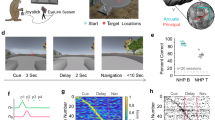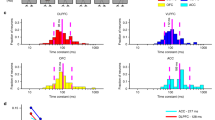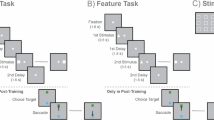Abstract
Persistent neural activity constitutes one neuronal correlate of working memory, the ability to hold and manipulate information across time, a prerequisite for cognition. Yet, the underlying neuronal mechanisms are still elusive. Here, we design a visuo- spatial delayed-response task to identify the relationship between the cue-distractor spatial distance and mnemonic accuracy. Using a shared experimental and computational test protocol, we probe human subjects in computer experiments, and subsequently we evaluate different neural mechanisms underlying persistent activity using an in silico prefrontal network model. Five modes of action of the network were tested: weak or strong synaptic interactions, wide synaptic arborization, cellular bistability and reduced synaptic NMDA component. The five neural mechanisms and the human behavioral data, all exhibited a significant deterioration of the mnemonic accuracy with decreased spatial distance between the distractor and the cue. A subsequent computational analysis revealed that the firing rate and not the neural mechanism per se, accounted for the positive correlation between mnemonic accuracy and spatial distance. Moreover, the computational modeling predicts an inverse correlation between accuracy and distractibility. In conclusion, any pharmacological modulation, pathological condition or memory training paradigm targeting the underlying neural circuitry and altering the net population firing rate during the delay is predicted to determine the amount of influence of a visual distraction.
Similar content being viewed by others
References
Abeles M (1991) Corticonics: neural circuits of the cerebral cortex. Cambridge University Press, Cambridge
Amari S (1977) Dynamics of pattern formation in lateral-inhibition type neural fields. Biol Cybern 27:77–87
Amit DJ (1995) The Hebbian paradigm reintegrated: local reverberations as internal representations. Behav Brain Sci 18:617–626
Amit DJ, Brunel N (1997) Model of global spontaneous activity and local structured activity during delay periods in the cerebral cortex. Cereb Cortex 7:237–252
Aura J, Riekkinen P Jr (1999) Blockade of NMDA receptors located at the dorsomedial prefrontal cortex impairs spatial working memory in rats. Neuroreport 10:243–248
Baddeley A (1986) Working memory. Oxford University Press, New York
Ben-Yishai R, Bar-Or RL, Sompolinsky H (1995) Theory of orientation tuning in visual cortex. Proc Natl Acad Sci USA 92:3844–3848
Ben-Yishai R, Hansel D, Sompolinsky H (1997) Traveling waves and the processing of weakly tuned inputs in a cortical network module. J Comput Neurosci 4:57–77
Brody CD, Romo R, Kepecs A (2003) Basic mechanisms for graded persistent activity: discrete attractors, continuous attractors, and dynamic representations. Curr Opin Neurobiol 13:204–211
Brunel N (1996) Hebbian learning of context in recurrent neural networks. Neural Comput 8:1677–1710
Compte A, Brunel N, Goldman-Rakic PS, Wang XJ (2000) Synaptic mechanisms and network dynamics underlying spatial working memory in a cortical network model. Cereb Cortex 10:910–923
Compte A, Constantinidis C, Tegnér J, Raghavachari S, Chafee MV, Goldman-Rakic PS, Wang XJ (2003) Temporally irregular mnemonic persistent activity in prefrontal neurons of monkeys during a delayed response task. J Neurophysiol 90:3441–3454
Constantinidis C, Franowicz MN, Goldman-Rakic PS (2001) Coding specificity in cortical microcircuits: a multiple-electrode analysis of primate prefrontal cortex. J Neurosci 21:3646–3655
Cornette L, Dupont P, Salmon E, Orban GA (2001) The neural substrate of orientation working memory. J Cogn Neurosci 13:813–828
de Fockert JW, Rees G, Frith CD, Lavie N (2001) The role of working memory in visual selective attention. Science 291:1803–1806
Diesmann M, Gewaltig MO, Aertsen A (1999) Stable propagation of synchronous spiking in cortical neural networks. Nature 402:529–533
Dudkin KN, Kruchinin VK, Chueva IV (1997) Effect of NMDA on the activity of cortical glutaminergic structures in delayed visual differentiation in monkeys. Neurosci Behav Physiol 27:153–158
Durstewitz D, Seamans JK, Sejnowski TJ (2000) Dopamine- mediated stabilization of delay-period activity in a network model of prefrontal cortex. J Neurophysiol 83:1733–1750
Egorov AV, Hamam BN, Fransen E, Hasselmo ME, Alonso AA (2002) Graded persistent activity in entorhinal cortex neurons. Nature 420:173–178
Fransen E, Lansner A (1998) A model of cortical associative memory based on a horizontal network of connected columns. Network 9:235–264
Funahashi S, Bruce CJ, Goldman-Rakic PS (1989) Mnemonic coding of visual space in the monkey’s dorsolateral prefrontal cortex. J Neurophysiol 61:331–349
Fuster JM (1973) Unit activity in prefrontal cortex during delayed-response performance: neuronal correlates of transient memory. J Neurophysiol 36:61–78
Fuster JM (1995) Memory in the cerebral cortex. MIT press, Cambrige
Fuster JM (1997) The prefrontal cortex: anatomy, physiology, and neuropsychology of the frontal lobe. Lippincott-Raven, New York
Gewaltig MO, Diesmann M, Aertsen A (2001) Propagation of cortical synfire activity: survival probability in single trials and stability in the mean. Neural Netw 14:657–673
Goldman MS, Levine JH, Major G, Tank DW, Seung HS (2003) Robust persistent neural activity in a model integrator with multiple hysteretic dendrites per neuron. Cereb Cortex 13:1185–1195
Goldman-Rakic PS (1987) Circuitry of primate prefrontal cortex and regulation of behavior by representational memory. In: Handbook of physiology. American Physiology Society, Bethesda, pp 373–417
Goldman-Rakic PS (1995) Cellular basis of working memory. Neuron 14:477–485
Gutkin BS, Laing CR, Colby CL, Chow CC, Ermentrout GB (2001) Turning on and off with excitation: the role of spike-timing asynchrony and synchrony in sustained neural activity. J Comput Neurosci 11:121–134
Haj-Dahmane S, Andrade R (1998) Ionic mechanism of the slow afterdepolarization induced by muscarinic receptor activation in rat prefrontal cortex. J Neurophysiol 80:1197–1210
Hebb DO (1949) The organization of behaviour. Wiley, New York
Hestrin S, Sah P, Nicoll RA (1990) Mechanisms generating the time course of dual component excitatory synaptic currents recorded in hippocampal slices. Neuron 5:247–253
Hopfield JJ (1982) Neural networks and physical systems with emergent collective computational abilities. Proc Natl Acad Sci USA 79:2554–2558
Jahr CE, Stevens CF (1990) Voltage dependence of NMDA- activated macroscopic conductances predicted by single-channel kinetics. J Neurosci 10:3178–3182
Kane MJ, Bleckley MK, Conway ARA, Engle RW (2001) A controlled-attention view of working-memory capacity. J Exp Psychol Gen 130:169–183
Klingberg T, Fernell E, Olesen PJ, Johnson M, Gustafsson P, Dahlstrom K, Gillberg CG, Forssberg H, Westerberg H (2005) Computerized training of working memory in children with ADHD—a randomized, controlled trial. J Am Acad Child Adolesc Psychiatry 44:177–186
Koulakov AA, Raghavachari S, Kepecs A, Lisman JE (2002) Model for a robust neural integrator. Nat Neurosci 5:775–782
Kritzer MF, Goldman-Rakic PS (1995) Intrinsic circuit organization of the major layers and sublayers of the dorsolateral prefrontal cortex in the rhesus monkey. J Comp Neurol 359:131–143
Lavie N, Hirst A, de Fockert JW, Viding E (2004) Load theory of selective attention and cognitive control. J Exp Psychol Gen 133:339–354
Lee RH, Heckman CJ (1998) Bistability in spinal motoneurons in vivo: systematic variations in persistent inward currents. J Neurophysiol 80:583–593
Levitt JB, Lewis DA, Yoshioka T, Lund JS (1993) Topography of pyramidal neuron intrinsic connections in macaque monkey prefrontal cortex (areas 9 and 46). J Comp Neurol 338:360–376
Lisman JE, Fellous JM, Wang XJ (1998) A role for NMDA- receptor channels in working memory. Nat Neurosci 1:273–275
Loewenstein Y, Sompolinsky H (2003) Temporal integration by calcium dynamics in a model neuron. Nat Neurosci 6:961–967
Macoveanu J, Klingberg T, Tegner J (2006) A biophysical model of multiple-item working memory: a computational and neuroimaging study. Neuroscience 141:1611–1618
Markram H, Lubke J, Frotscher M, Roth A, Sakmann B (1997) Physiology and anatomy of synaptic connections between thick tufted pyramidal neurones in the developing rat neocortex. J Physiol 500(Pt 2):409–440
McCormick DA, Connors BW, Lighthall JW, Prince DA (1985) Comparative electrophysiology of pyramidal and sparsely spiny stellate neurons of the neocortex. J Neurophysiol 54: 782–806
Miller EK, Cohen JD (2001) An integrative theory of prefrontal cortex function. Annu Rev Neurosci 24:167–202
Miller EK, Erickson CA, Desimone R (1996) Neural mechanisms of visual working memory in prefrontal cortex of the macaque. J Neurosci 16:5154–5167
Mountcastle VB (1997) The columnar organization of the neocortex. Brain 120(Pt 4):701–722
Norman DA (1970) Models of human memory. Academic, New York
Olesen PJ, Westerberg H, Klingberg T (2004) Increased prefrontal and parietal activity after training of working memory. Nat Neurosci 7:75–79
Olesen PJ, Macoveanu J, Klingberg T (2005) Childhood development of brain activity related to working memory and distractor processing (unpublished)
Ploner CJ, Gaymard B, Rivaud S, Agid Y, Pierrot-Deseilligny C (1998) Temporal limits of spatial working memory in humans. Eur J Neurosci 10:794–797
Roberts RJ, Hager LD, Heron C (1994) Prefrontal cognitive processes working memory and inhibition in the antisaccade task. J Exp Psychol Gen 123:374–393
Sakai K, Rowe JB, Passingham RE (2002) Active maintenance in prefrontal area 46 creates distractor-resistant memory. Nat Neurosci 5:479–484
Salin PA, Prince DA (1996) Electrophysiological mapping of GABAA receptor-mediated inhibition in adult rat somatosensory cortex. J Neurophysiol 75:1589–1600
Sandberg A, Tegnér J, Lansner A (2003) A working memory model based on fast Hebbian learning. Network 14:789–802
Scherzer CR, Landwehrmeyer GB, Kerner JA, Counihan TJ, Kosinski CM, Standaert DG, Daggett LP, Velicelebi G, Penney JB, Young AB (1998) Expression of N-methyl-D-aspartate receptor subunit mRNAs in the human brain: hippocampus and cortex. J Comp Neurol 390:75–90
Schiller J, Schiller Y (2001) NMDA receptor-mediated dendritic spikes and coincident signal amplification. Curr Opin Neurobiol 11:343–348
Seung HS (1996) How the brain keeps the eyes still. Proc Natl Acad Sci USA 93:13339–13344
Seung HS, Lee DD, Reis BY, Tank DW (2000) Stability of the memory of eye position in a recurrent network of conductance-based model neurons. Neuron 26:259–271
Shima K, Tanji J (1998) Involvement of NMDA and non-NMDA receptors in the neuronal responses of the primary motor cortex to input from the supplementary motor area and somatosensory cortex: studies of task-performing monkeys. Jpn J Physiol 48:275–290
Singer W (1993) Synchronization of cortical activity and its putative role in information processing and learning. Annu Rev Physiol 55:349–374
Spruston N, Jonas P, Sakmann B (1995) Dendritic glutamate receptor channels in rat hippocampal CA3 and CA1 pyramidal neurons. J Physiol 482(Pt 2):325–352
Tegnér J, Compte A, Wang XJ (2002) The dynamical stability of reverberatory neural circuits. Biol Cybern 87:471–481
Thomas HB (1968) An information-theoretic model for the serial position effect. Psychol Rev 75:409–420
Todd JJ, Marois R (2004) Capacity limit of visual short-term memory in human posterior parietal cortex. Nature 428:751–754
Treisman AM, Gelade G (1980) A feature-integration theory of attention. Cognit Psychol 12:97–136
Vogel EK, Machizawa MG (2004) Neural activity predicts individual differences in visual working memory capacity. Nature 428:748–751
Wang XJ (1999) Synaptic basis of cortical persistent activity: the importance of NMDA receptors to working memory. J Neurosci 19:9587–9603
Wang XJ (2001) Synaptic reverberation underlying mnemonic persistent activity. Trends Neurosci 24:455–463
Wang XJ, Tegnér J, Constantinidis C, Goldman-Rakic PS (2004) Division of labor among distinct subtypes of inhibitory neurons in a cortical microcircuit of working memory. Proc Natl Acad Sci USA 101:1368–1373
White JM, Sparks DL, Stanford TR (1994) Saccades to remembered target locations: an analysis of systematic and variable errors. Vis Res 34:79–92
Xiang Z, Huguenard JR, Prince DA (2002) Synaptic inhibition of pyramidal cells evoked by different interneuronal subtypes in layer v of rat visual cortex. J Neurophysiol 88:740–750
Author information
Authors and Affiliations
Corresponding author
Rights and permissions
About this article
Cite this article
Macoveanu, J., Klingberg, T. & Tegnér, J. Neuronal firing rates account for distractor effects on mnemonic accuracy in a visuo-spatial working memory task. Biol Cybern 96, 407–419 (2007). https://doi.org/10.1007/s00422-006-0139-8
Received:
Accepted:
Published:
Issue Date:
DOI: https://doi.org/10.1007/s00422-006-0139-8




